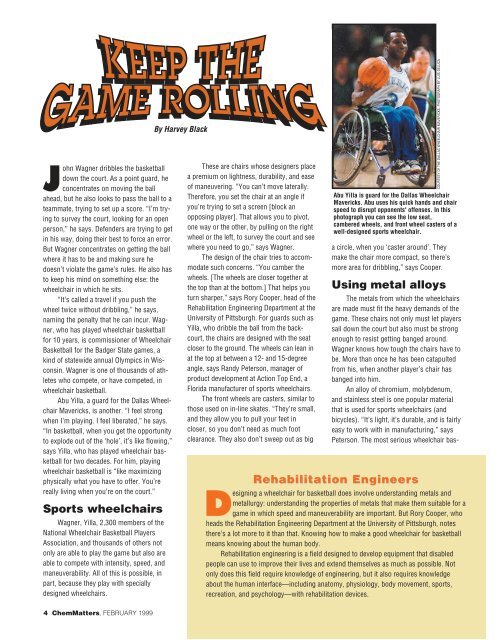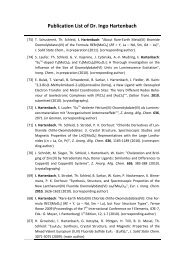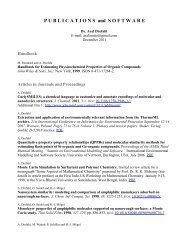Sports Drinks: Don't Sweat the Small Stuff - American Chemical ...
Sports Drinks: Don't Sweat the Small Stuff - American Chemical ...
Sports Drinks: Don't Sweat the Small Stuff - American Chemical ...
You also want an ePaper? Increase the reach of your titles
YUMPU automatically turns print PDFs into web optimized ePapers that Google loves.
John Wagner dribbles <strong>the</strong> basketball<br />
down <strong>the</strong> court. As a point guard, he<br />
concentrates on moving <strong>the</strong> ball<br />
ahead, but he also looks to pass <strong>the</strong> ball to a<br />
teammate, trying to set up a score. “I’m trying<br />
to survey <strong>the</strong> court, looking for an open<br />
person,” he says. Defenders are trying to get<br />
in his way, doing <strong>the</strong>ir best to force an error.<br />
But Wagner concentrates on getting <strong>the</strong> ball<br />
where it has to be and making sure he<br />
doesn’t violate <strong>the</strong> game’s rules. He also has<br />
to keep his mind on something else: <strong>the</strong><br />
wheelchair in which he sits.<br />
“It’s called a travel if you push <strong>the</strong><br />
wheel twice without dribbling,” he says,<br />
naming <strong>the</strong> penalty that he can incur. Wagner,<br />
who has played wheelchair basketball<br />
for 10 years, is commissioner of Wheelchair<br />
Basketball for <strong>the</strong> Badger State games, a<br />
kind of statewide annual Olympics in Wisconsin.<br />
Wagner is one of thousands of athletes<br />
who compete, or have competed, in<br />
wheelchair basketball.<br />
Abu Yilla, a guard for <strong>the</strong> Dallas Wheelchair<br />
Mavericks, is ano<strong>the</strong>r. “I feel strong<br />
when I’m playing. I feel liberated,” he says.<br />
“In basketball, when you get <strong>the</strong> opportunity<br />
to explode out of <strong>the</strong> ‘hole’, it’s like flowing,”<br />
says Yilla, who has played wheelchair basketball<br />
for two decades. For him, playing<br />
wheelchair basketball is “like maximizing<br />
physically what you have to offer. You’re<br />
really living when you’re on <strong>the</strong> court.”<br />
<strong>Sports</strong> wheelchairs<br />
Wagner, Yilla, 2,300 members of <strong>the</strong><br />
National Wheelchair Basketball Players<br />
Association, and thousands of o<strong>the</strong>rs not<br />
only are able to play <strong>the</strong> game but also are<br />
able to compete with intensity, speed, and<br />
maneuverability. All of this is possible, in<br />
part, because <strong>the</strong>y play with specially<br />
designed wheelchairs.<br />
4 ChemMatters, FEBRUARY 1999<br />
By Harvey Black<br />
These are chairs whose designers place<br />
a premium on lightness, durability, and ease<br />
of maneuvering. “You can’t move laterally.<br />
Therefore, you set <strong>the</strong> chair at an angle if<br />
you’re trying to set a screen [block an<br />
opposing player]. That allows you to pivot,<br />
one way or <strong>the</strong> o<strong>the</strong>r, by pulling on <strong>the</strong> right<br />
wheel or <strong>the</strong> left, to survey <strong>the</strong> court and see<br />
where you need to go,” says Wagner.<br />
The design of <strong>the</strong> chair tries to accommodate<br />
such concerns. “You camber <strong>the</strong><br />
wheels. [The wheels are closer toge<strong>the</strong>r at<br />
<strong>the</strong> top than at <strong>the</strong> bottom.] That helps you<br />
turn sharper,” says Rory Cooper, head of <strong>the</strong><br />
Rehabilitation Engineering Department at <strong>the</strong><br />
University of Pittsburgh. For guards such as<br />
Yilla, who dribble <strong>the</strong> ball from <strong>the</strong> backcourt,<br />
<strong>the</strong> chairs are designed with <strong>the</strong> seat<br />
closer to <strong>the</strong> ground. The wheels can lean in<br />
at <strong>the</strong> top at between a 12- and 15-degree<br />
angle, says Randy Peterson, manager of<br />
product development at Action Top End, a<br />
Florida manufacturer of sports wheelchairs.<br />
The front wheels are casters, similar to<br />
those used on in-line skates. “They’re small,<br />
and <strong>the</strong>y allow you to pull your feet in<br />
closer, so you don’t need as much foot<br />
clearance. They also don’t sweep out as big<br />
Abu Yilla is guard for <strong>the</strong> Dallas Wheelchair<br />
Mavericks. Abu uses his quick hands and chair<br />
speed to disrupt opponents' offenses. In this<br />
photograph you can see <strong>the</strong> low seat,<br />
cambered wheels, and front wheel casters of a<br />
well-designed sports wheelchair.<br />
a circle, when you ‘caster around’. They<br />
make <strong>the</strong> chair more compact, so <strong>the</strong>re’s<br />
more area for dribbling,” says Cooper.<br />
Using metal alloys<br />
The metals from which <strong>the</strong> wheelchairs<br />
are made must fit <strong>the</strong> heavy demands of <strong>the</strong><br />
game. These chairs not only must let players<br />
sail down <strong>the</strong> court but also must be strong<br />
enough to resist getting banged around.<br />
Wagner knows how tough <strong>the</strong> chairs have to<br />
be. More than once he has been catapulted<br />
from his, when ano<strong>the</strong>r player’s chair has<br />
banged into him.<br />
An alloy of chromium, molybdenum,<br />
and stainless steel is one popular material<br />
that is used for sports wheelchairs (and<br />
bicycles). “It’s light, it’s durable, and is fairly<br />
easy to work with in manufacturing,” says<br />
Peterson. The most serious wheelchair bas-<br />
Rehabilitation Engineers<br />
Designing a wheelchair for basketball does involve understanding metals and<br />
metallurgy: understanding <strong>the</strong> properties of metals that make <strong>the</strong>m suitable for a<br />
game in which speed and maneuverability are important. But Rory Cooper, who<br />
heads <strong>the</strong> Rehabilitation Engineering Department at <strong>the</strong> University of Pittsburgh, notes<br />
<strong>the</strong>re’s a lot more to it than that. Knowing how to make a good wheelchair for basketball<br />
means knowing about <strong>the</strong> human body.<br />
Rehabilitation engineering is a field designed to develop equipment that disabled<br />
people can use to improve <strong>the</strong>ir lives and extend <strong>the</strong>mselves as much as possible. Not<br />
only does this field require knowledge of engineering, but it also requires knowledge<br />
about <strong>the</strong> human interface—including anatomy, physiology, body movement, sports,<br />
recreation, and psychology—with rehabilitation devices.<br />
COURTESY OF THE DALLAS WHEELCHAIR MAVERICKS. PHOTOGRAPH BY LUIS DELUCA













